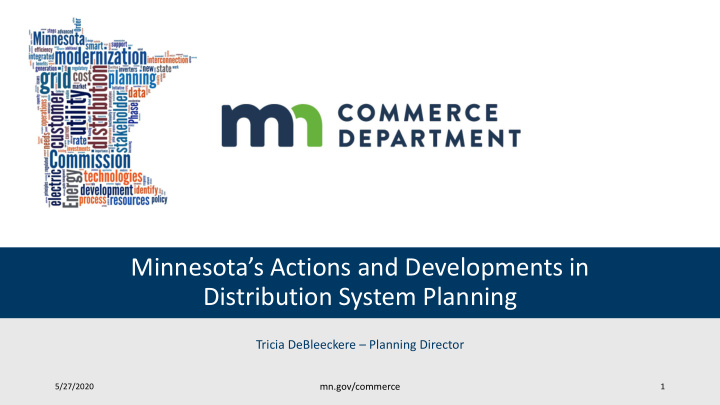



Minnesota’s Actions and Developments in Distribution System Planning Tricia DeBleeckere – Planning Director 5/27/2020 mn.gov/commerce 1
Overview • Commission-led Investigation – Workshops, Reports, Questionnaire • Opened Individual Investigation Dockets for each of the four-rate regulated utilities • Distribution Planning Filing Requirements Established by Order • Integrated Distribution Plans filed in 2018 and 2019 • Evaluation and Improvement of Plans Distribution Planning in Minnesota | https://mn.gov/commerce 2
Workshops and Reports 3
Questionnaire Scenario Planning Load Forecasts Hosting Capacity Risk Analysis State of the Investments Mitigation State Distributed Resources Budgeting Technological Changes ? C. Are there ways to improve or A. How do Minnesota utilities B. What does each utilities augment the utilities’ planning currently plan their current year plan look like processes? distribution systems? and assume? Provide stakeholders an opportunity Establish a baseline understanding Understand the current state of to identify potential improvements in of our utility planning processes plans planning processes Distribution Planning in Minnesota | https://mn.gov/commerce 4
Goals for Integrated Distribution Planning Process Minnesota- based Integrated Distribution Plan ‘wants’: • foundational understanding of utility’s long -term distribution plans; • context for individual utility investment requests; • proactive consideration of potential futures and non-traditional methods of planning; • system reliability, efficient uses of resources, and maximized customer benefits; and, • public policy goals achievement. Distribution Planning in Minnesota | https://mn.gov/commerce
Distribution System Planning Questionnaire - Takeaways Utility Similarities : • Annual distribution system capital budgets; • Metrics for planning; • Low load growth and DER penetration; • Varied system visibility even within distribution systems; • Limited distribution engineering staff; • Limited connection between DSP and IRP/Transmission Planning; and, • DER treatment in forecasts (short term energy vs. long term capacity). Distribution Planning in Minnesota | https://mn.gov/commerce 6
Distribution System Planning Questionnaire - Takeaways Utility Differences : • Various stages of grid modernization; • Degrees of implemented technology and how used; • Levels of DER-interconnection requests and DER-penetration levels; • Distribution system spend by year (factor of 10); • Geographic region and density; • Occurrences of (and need for) special distribution projects or studies; and, • Age of existing infrastructure. Distribution Planning in Minnesota | https://mn.gov/commerce 7
Process for Setting Distribution Plan Requirements Commission Review Staff Straw Commission and Approval for Comment Period Proposals Decision Release April 2018 August 2018 Distribution Planning in Minnesota | https://mn.gov/commerce
Planning Objectives The Commission is facilitating comprehensive, coordinated, transparent, integrated distribution plans to: • Maintain and enhance the safety, security, reliability, and resilience of the electricity grid, at fair and reasonable costs, consistent with the state’s energy policies; • Enable greater customer engagement, empowerment, and options for energy services; • Move toward the creation of efficient, cost-effective, accessible grid platforms for new products, new services, and opportunities for adoption of new distributed technologies; and, • Ensure optimized utilization of electricity grid assets and resources to minimize total system costs. • Provide the Commission with the information necessary to understand Xcel’s short -term and long- term distribution system plans, the costs and benefits of specific investments, and a comprehensive analysis of ratepayer cost and value. (Source: IDP Filing Requirements as adopted in 2018) 5/27/2020 Distribution Planning in Minnesota | https://mn.gov/commerce 9
Defining DER Distributed Energy Resources (DER) is defined as “supply and demand side resources that can be used throughout an electric distribution system to meet energy and reliability needs of customers; can be installed on either the customer or utility side of the electric meter.” This definition for this filing may include, but is not limited to: distributed generation, energy storage, electric vehicles, demand side management, and energy efficiency. (Source: IDP Filing Requirements as adopted in 2018. Based on See Minnesota Staff Grid Modernization Report, March 2016 and ICF Report, Integrated Distribution Planning, August 2016, prepared for Minnesota Public Utilities Commission, Docket No. E999/CI-15-556) 5/27/2020 Distribution Planning in Minnesota | https://mn.gov/commerce 10
Integrated Distribution Plan Requirements 1. Administrative Requirements (Timing) 2. Stakeholder Process 3. Filing Requirements A. Baseline Data B. Hosting Capacity and Interconnection C. DER Forecasting Each Draft-IDP is tailored and specific to each utility and expected D. Long-Term Distribution Investment Plan to diverge further over time. E. Non-Wires Alternatives Analysis Distribution Planning in Minnesota | https://mn.gov/commerce
Filling Requirements - Flexibility 5/27/2020 12
Integrated Distribution Plan Requirements Baseline Data Baseline Data System, Financial, DER
Integrated Distribution Plan Requirements Hosting Capacity & Interconnection Hosting Capacity and Interconnection
Integrated Distribution Plan Requirements DER Scenario Analysis DER Scenario Analysis
Integrated Distribution Plan Requirements Grid Modernization Long-Term Distribution System Modernization and Infrastructure Plan
Integrated Distribution Plan Requirements Non-Wires Alternatives Non-Wires Alternatives Analysis
Integrated Distribution Planning What we will learn…. What is possible and reasonable? What progress and investments are worthwhile, in what order? Speed vs. Value What information will be required to substantiate or support investments? Where are areas we should push our utilities? What is needed to advance the distribution system in the public interest? Distribution Planning in Minnesota | https://mn.gov/commerce
1 st Integrated Distribution Plans Utility Dockets Xcel Energy 18-251 (2018 IDP); 19-666 (2019 IDP & Advanced Grid Certification Requests) Minnesota Power 19-684 (2019 IDP) Dakota Electric Assn. 19-674 (2019 IDP) Otter Tail Power 19-693 (2019 IDP) 5/27/2020 Distribution Planning in Minnesota | https://mn.gov/commerce 19
Integrated Distribution Plan Requirements What Lies Ahead? How will integrated distribution system planning evolve? Distribution Planning in Minnesota | https://mn.gov/commerce
Questions? Tricia DeBleeckere Tricia.DeBleeckere@state.mn.us Distribution Planning in Minnesota 21
Recommend
More recommend